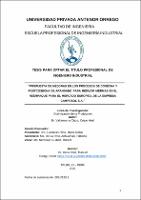| dc.contributor.advisor | Urcia Cruz, Manuel | |
| dc.contributor.author | Valderrama Cieza, César Abel | |
| dc.creator | Valderrama Cieza, César Abel | |
| dc.date.accessioned | 2022-03-14T02:09:10Z | |
| dc.date.available | 2022-03-14T02:09:10Z | |
| dc.date.issued | 2022 | |
| dc.identifier.uri | https://hdl.handle.net/20.500.12759/8753 | |
| dc.description.abstract | La presente tesis plantea una propuesta de estrategias a implementarse en
los procesos de cosecha y postcosecha del arándano fresco, para mejorar su
calidad al arribo y de esta forma, reducir los porcentajes de merma obtenidos
durante su reempaque en el mercado europeo en la campaña 2020/21 versus
los resultados de la campaña previa. La estructura presente en este trabajo
de investigación se ha enfocado en la metodología del Ciclo PHVA. Primero
se describe la situación actual de las mermas en el reempaque de Europa,
durante la campaña 2019/20 este proceso tuvo un 10% promedio de merma
con picos de hasta 25%, junto con los siguientes principales defectos de
calidad al arribo: bayas reventadas, incidencia de pudrición, fruta blanda e
incidencia de micelio. Posterior a esto se comienza la planificación de las
estrategias a implementar, seleccionando las etapas críticas en los procesos
de cosecha y postcosecha que estén comprometiendo la calidad del producto
al arribo (utilizando el método de análisis multicriterio) y gestionando la
implementación cada estrategia de las etapas críticas, junto con todas las
áreas involucradas en el proyecto, donde se detalla el paso a paso de cada
implementación. Obteniendo durante la campaña 2020/21 una reducción del
porcentaje promedio de merma de siete puntos porcentuales y una tendencia
semanal del porcentaje de merma por debajo del límite máximo permitido
(5%). A su vez se determinan los beneficios económicos obtenidos con la
reducción del porcentaje de merma en el mercado europeo. Por lo tanto, se
concluye que la implementación de las estrategias de mejora en los procesos
de cosecha y postcosecha, han logrado reducir el porcentaje de merma del
arándano fresco en los reempaques del mercado europeo, pasando de 10%
a 3% y con un beneficio económico de $500,360.04 durante esta campaña
2020/21. | es_PE |
| dc.description.abstract | This thesis presents a proposal of strategies to be implemented in the harvest
and postharvest processes of fresh blueberries, to improve their quality upon
arrival and, in this way, reduce waste percentages, that are obtained during
their repacking in the European market of the 2020/21 season versus the
results of the previous one. The present structure in this research has been
focused on the PDCA Cycle methodology. First, the current situation of waste
in Europe’s repacking process is described, during the 2019/20 season this
process had an average 10% waste with peaks of up to 25%, along with the
following main quality defects upon arrival: collapsed berries, rot incidence,
soft fruit, and mycelium incidence (mold). After this, it begins the planning of
the strategies to be implemented, selecting the critical stages in the harvest
and post-harvest processes that are compromising the quality of the product
upon arrival (using the multi-criteria analysis method) and managing the
implementation of each strategy of the critical stages, along with all the
involved departments in the project, where the step-by-step of each
implementation is detailed. Obtaining during the 2020/21 season, a reduction
in the average waste percentage of seven percentage points and a weekly
trend of the waste percentage below the maximum allowed limit (5%). In turn,
the economic benefits obtained with the reduction of the waste percentage in
the European market are determined. Therefore, it is concluded that the
implementation of improvement strategies in the harvest and post-harvest
processes have managed to reduce the percentage of fresh blueberries waste
in the repacking of the European market, going from 10% to 3% and with an
economic benefit of $ 500,360.04 during this 2020/21 season. | en_US |
| dc.description.uri | Tesis | es_PE |
| dc.format | application/pdf | es_PE |
| dc.language.iso | spa | es_PE |
| dc.publisher | Universidad Privada Antenor Orrego | es_PE |
| dc.relation.ispartofseries | T_IND_181 | |
| dc.rights | info:eu-repo/semantics/closedAccess | es_PE |
| dc.rights.uri | https://creativecommons.org/licenses/by/4.0/ | es_PE |
| dc.source | Universidad Privada Antenor Orrego | es_PE |
| dc.source | Repositorio Institucional - UPAO | es_PE |
| dc.subject | Cosecha y Postcosecha | es_PE |
| dc.subject | Ciclo PHVA | es_PE |
| dc.title | Propuesta de mejoras en los procesos de cosecha y postcosecha de arándano para reducir mermas en el reempaque para el mercado europeo de la empresa Camposol S.A | es_PE |
| dc.type | info:eu-repo/semantics/bachelorThesis | es_PE |
| thesis.degree.level | Título Profesional | es_PE |
| thesis.degree.grantor | Universidad Privada Antenor Orrego. Facultad de Ingeniería | es_PE |
| thesis.degree.name | Ingeniero Industrial | es_PE |
| thesis.degree.discipline | Ingeniería Industrial | es_PE |
| dc.subject.ocde | https://purl.org/pe-repo/ocde/ford#2.11.04 | es_PE |
| renati.advisor.orcid | https://orcid.org/0000-0001-8286-0597 | es_PE |
| renati.author.dni | 72223312 | |
| renati.advisor.dni | 18208167 | |
| renati.type | https://purl.org/pe-repo/renati/type#tesis | es_PE |
| renati.level | https://purl.org/pe-repo/renati/level#tituloProfesional | es_PE |
| renati.discipline | 722026 | es_PE |
| renati.juror | Landeras Pilco, María Isabel | |
| renati.juror | De La Rosa Anhuaman, Filiberto | |
| renati.juror | Neciosup Guibert, Robert | |
| dc.publisher.country | PE | es_PE |


